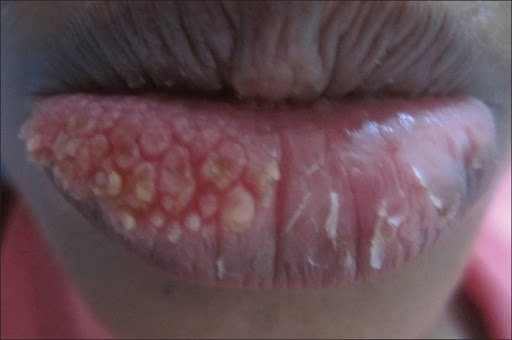Multiple Hamartoma Syndrome
Clinical Features, Genes and Therapeutics

Multiple hamartoma syndrome (sometimes called Cowden syndrome Opens in new window; PTEN hamartoma-tumor syndrome) is an inherited autosomal dominant trait with a high degree of penetrance and a range of expressivity. Cutaneous manifestations are present in almost all patients with multiple hamartoma syndrome, usually developing during the second decade of life.
The majority of the skin lesions appear as multiple, small (less than 1 mm) papules, primarily on the facial skin, especially around the mouth, nose, and ears. Microscopically, most of these represent hair follicle hamartomas called trichilemmomas.
Other notable skin lesions are acral keratosis, a warty-appearing growth that develops on the dorsal surface of the hand, and palmoplantar keratosis, a prominent callus-like lesion on the palms or soles.
Multiple hamartoma syndrome has important implications for the affected patient, because malignancies, in addition to the benign hamartomatous growths, develop in a high percentage of these individuals.
Other problems can appear in these patients as well. Thyroid disease usually appears as either a goiter or a thyroid adenoma, but papillary or follicular adenocarcinoma may develop.
In one series, thyroid malignancy was identified in 14% of patients with this condition. In women, fibrocystic disease of the breast is frequently observed.
Unfortunately, breast cancer occurs with a relatively high frequency (25% to 50%) in these patients. The mean age at diagnosis of breast malignancy is 40 years, which is much younger than usual.
In the gastrointestinal tract, multiple bening hamartomatous polyps may be present. In addition, several types of benign and malignant tumors of the female genitourinary tract occur more often than in the normal population.
The oral lesions vary in severity from patient to patient and usually consist of multiple papules affecting the gingivae, dorsal tongue, and buccal mucosa. These lesions have been reported in more than 80% of affected patients and generally produce no symptoms.
Other possible oral findings include a high-arched palate, periodontitis, and extensive dental caries, although it is unclear whether the latter two conditions are significantly related to the syndrome.
Gene Description
The gene responsible for this disorder has been mapped to chromosome 10, and a mutation of the phosphate and tensin homolog deleted on chromosome 10 (PTEN) gene has been implicated in its pathogenesis.
The estimated prevalence of this condition is approximately 1 in 200,000, and more than 300 affected patients have been described in the literature.
In recent years, overlapping clinical features of multiple hamartoma syndrome with Lhermitte-Duclos disease Opens in new window, Bannayan-Riley-Ruvalcaba syndrome Opens in new window, and Proteus-like syndrome Opens in new window have been noted, and all of these disorders have demonstrated mutations of the PTEN gene.
Diagnosis
The diagnosis of multiple hamartoma syndrome can be based on the finding of two of the following three pathognomonic signs:
- Multiple facial trichilemmomas
- Multiple oral papules
- Acral keratoses
A variety of other major and minor diagnostic criteria, as well as a positive family history, are also helpful in confirming the diagnosis.
Genetic testing for mutations of the PTEN gene are clinically available, but 20% of patients who otherwise have characteristic multiple hamartoma syndrome will not demonstrate a genetic abnormality; therefore, a negative test does not necessarily preclude the diagnosis of multiple hamartoma syndrome.
Treatment and Prognosis
Treatment of multiple hamartoma syndrome is controversial. Although most of the tumors that develop are benign, the prevalence of malignancy is higher in the general population; therefore, annual physical examinations should be performed that focus specifically on anatomic sites of increased tumor prevalence, particularly breast, uterus, and thyroid.
Some investigators recommend bilateral prophylactic mastectomies as early as the third decade of life for female patient because of the associated increased risk of breast cancer.
- Bagan JV, Penarrocha M, Vera-Sempere F: Cowden syndrome: clinical and pathological considerations in two new cases, J Oral Maxillofac Surg 47: 291-294, 1989.
- Devlin MF, Barrie R, Ward-Booth RP: Cowden’s disease: a rare but important manifestation of oral papillomatosis, Br J Oral Maxillofac Surg 30:335-336, 1992.
- Leao JC, Batista V, Guimaraes PB, et al: Cowden’s syndrome affecting the mouth, gastrointestinal, and central nervous system: a case report and review of the literature, Oral Surg Oral Med Oral Pathol Oral Radiol Endod 99:569-572, 2005.
- Mignogna MD, Lo Muzio L., Ruocco V, et al: Early diagnosis of multiple hamartoma and neoplasia syndrome (Cowden disease): The role of the dentist, Oral Surg Oral Med Oral Pathol Oral Radiol Endod 79:295-299, 1995.
- Porter S, Cawson R, Scully C, et al: Multiple hamartoma syndrome presenting with oral lesions, Oral Surg Oral Med Oral Pathol Oral Radiol Endod 82:295-301, 1996.
- Schaffer JV, Kamino H, Witkiewicz A, et al: Mucocutaneous neuromas: an underrecognized manifestation of PTEN hamartoma-tumor syndrome, Arch Dermatol 142:625-632, 2006.

